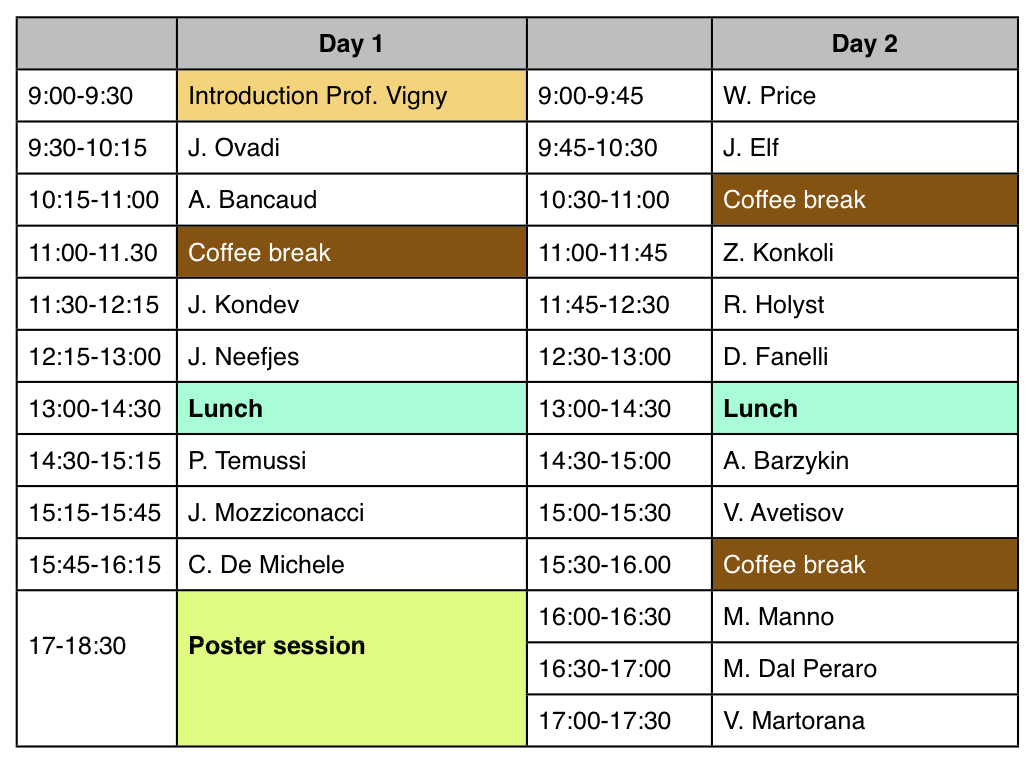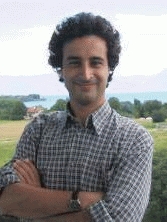Macromolecular crowding effects in cell biology: models and experiments
Orléans, France, 24-25 October 2013

Invited speakers
- Duccio Fanelli ,
Department of Physics, University of Florence, Florence, ItalyModified diffusion equations from microscopic exclusion processes - Massimo Vassalli/Vincenzo Martorana ,
Institute of Biophysics, CNR, Genova, ItalyComparing natural and artificial crowding in chicken eggs - Mauro Manno ,
Institute of Biophysics, CNR, Palermo, ItalyElectrostatic repulsion mimics molecular crowding and selects the fibrillation pathway in fibril-forming protein solutions - Aurelien Bancaud ,
Laboratoire d'analyse et d'architecture des systèmes (LAAS), Toulouse, FranceRelevance and limitations of crowding, fractal, and polymer models to describe nuclear architecture: is a unified picture out of reach? - Robert Holyst ,
Institute of Physical Chemistry, Polish Academy of sciences, Warsaw, PolandBiologistics: how to quantify the effect of macromolecular crowding on mobility of proteins, their association and gene expression? - Johan Elf ,
Department of Cell and Molecular Biology, Uppsala University, SwedenSingle molecule tracking in a crowded cell - Jacques J. Neefjes ,
Division of Cell Biology, Netherlands Cancer Institute, Amsterdam, The NetherlandsThe ins and outs of presenting infections to the immune system - Judit Ovadi ,
Institute of Enzymology, Research Centre for Natural Sciences,Hungarian Academy of Sciences, Budapest, HungaryMacromolecular Architectures in the Cytoplasm Derived by Moonlighting Proteins - Jané Kondev ,
Physics department, Brandeis University, Waltham, U.S.A.The cell as a poorly mixed chemical reactor - Piero Andrea Temussi ,
Molecular Structure Division, MRC National Institute for Medical Research, London, U.K. And the University of Naples, Naples, ItalyDenatured proteins: claustrophobic or agoraphobic? A direct comparison of protein stability in crowding and confining environments - Matteo Dal Peraro ,
Laboratory for Biomolecular Modeling, EPFL, Lausanne, Switzerland (to be confirmed)Exploring the impact of crowded conditions on internal protein dynamics through atomistic molecular dynamics simulations - Julien Mozziconacci ,
Laboratoire de Physique Théorique de la Matière Condensée, Université Pierre et Marie Curie, Paris, FranceTubulin dimers oligomerize before their incorporation into microtubules - William S. Price ,
Nanoscale Organisation and Dynamics Group, University of Western Sydney, Penrith South NSW 2751, AustraliaProbing Molecular Motion in Biological Systems Using NMR Diffusion Measurements - Zoran Konkoli ,
BioNano Systems Laboratory, Department of Microtechnology and Nanoscience - MC2, Chalmers University of Technology, Goteborg, SwedenDiffusion controlled reactions (DCR) in small and structured spaces as a tool for describing living cell biochemistry: challenges and opportunities - Vladik A. Avetisov ,
Semenov Institute of Chemical Physics, Russian Academy of Sciences, Moscow, RussiaProtein dynamic and protein functioning - Alexander V. Barzykin ,
Royal Bank of Scotland, London, U.K.Search for a small hole in a cavity wall by intermittent bulk and surface diffusion - Cristiano De Michele ,
Department of Physics, University of Roma "La Sapienza", RomeShort DNA duplexes self-assembly: assessment of a recent theoretical approach through computer simulations

Ice-breaker party, 23rd October, 18:30
 |
The city of Orleans will organize a welcome cocktail for
the conference participants in the beautiful "Hotel Groslot",
preceded by a short tour (approximately 60 mins) of the city center.
|
 |
Laboratoire de Biophysique Statistique (LBS) EPF-Lausanne, SUISSE "With a little help from my friends": the supervised life of proteins, from birth to death The life of a protein bears many analogies with the life of people. Birth, maturation, adulthood and ultimately aging and death are all features common to both. As well, just as we can find help in other people, like medical doctors, therapists, and of course friends, proteins can use some assistance from a special class of other proteins, broadly known as "chaperones", that supervise their behavior across the various stages of their life. Here we are giving an introduction to chaperone proteins, from their discovery to their disparate functions, that have been discovered to date. A shuttle bus will be provided for the participants from the CNRS campus |